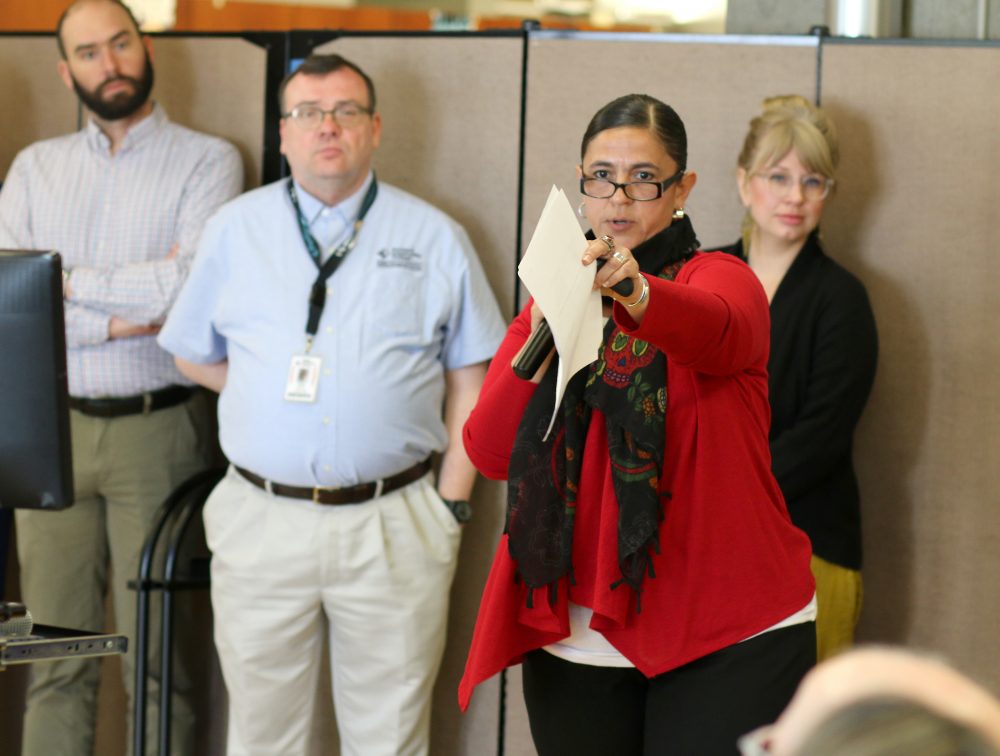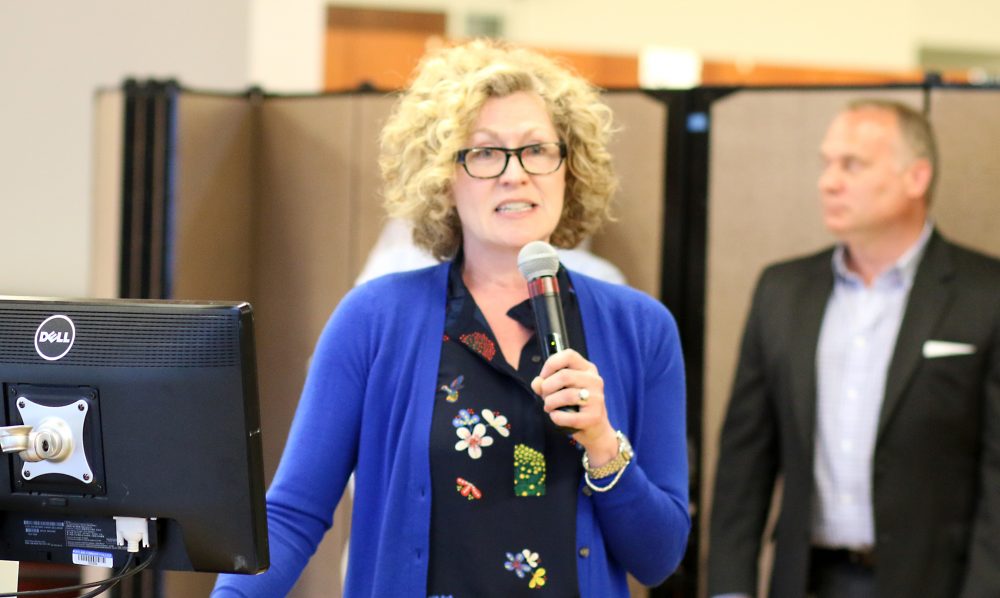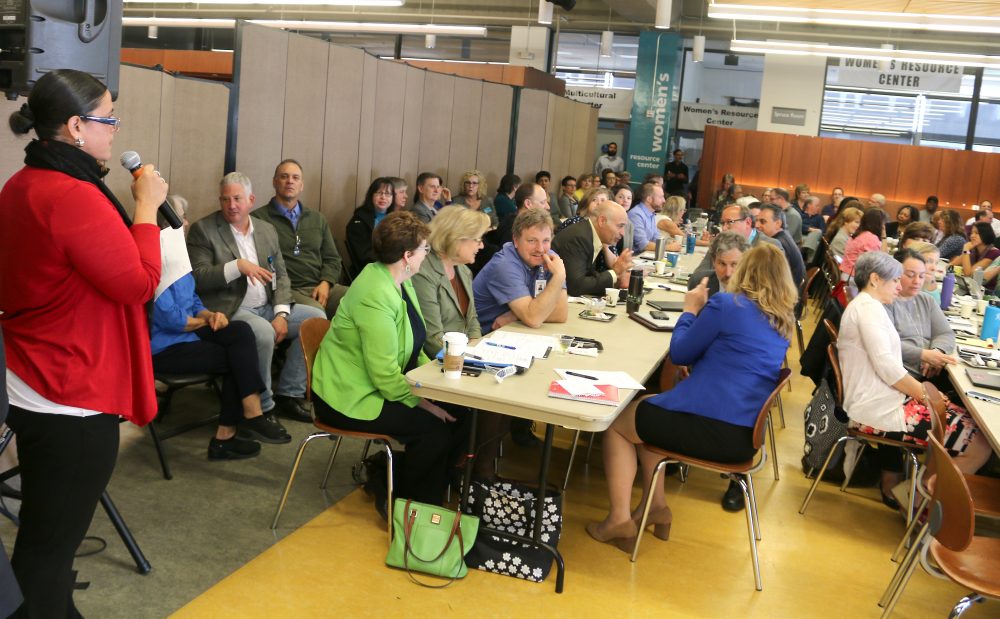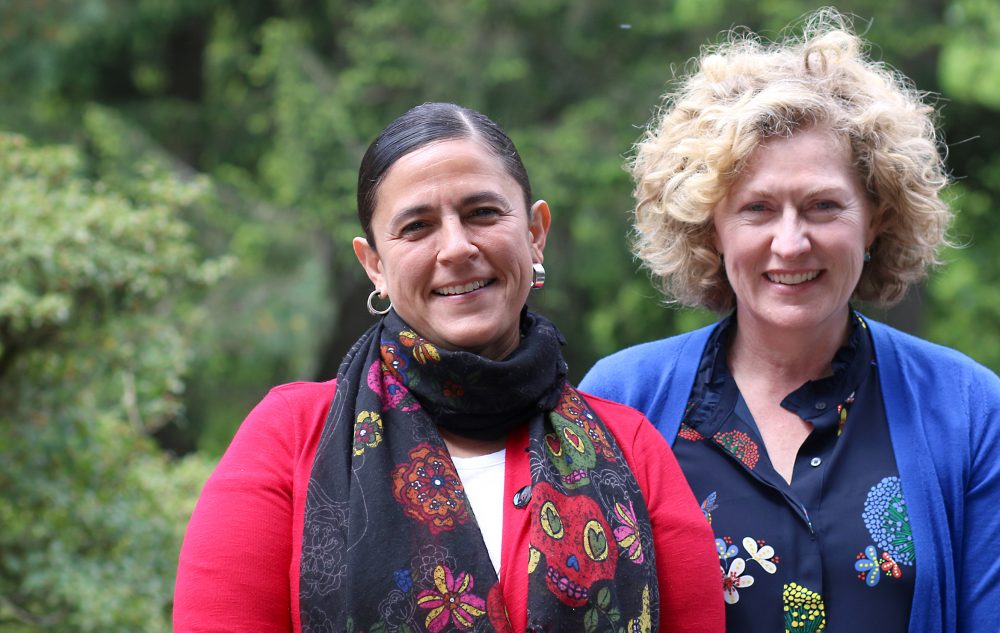This content was published: May 28, 2018. Phone numbers, email addresses, and other information may have changed.
PCC employs a holistic – and equitable – approach to facilities planning
Photos and Story by Kate Chester

Amara Pérez presents findings infused by the application of Critical Race Theory at a recent PCC All-Managers meeting.
Since its inception in 1961, Portland Community College has grown to include four comprehensive campuses and eight centers or areas served across a 1,500-square-mile service district area spanning five counties — Multnomah, Washington, Yamhill, Clackamas and Columbia. Historically, development of the college’s facilities has been approached site-by-site as growth needs dictate. However, a 2015 accreditation visit to PCC opened up the opportunity to launch a large-scale, college-wide integrated planning effort that brought together facilities, academics, information technology, and more.
This would be PCC’s first-ever attempt at conducting a system-wide planning analysis. It was a Herculean assignment because of its scope but a necessary one, both to meet accreditation needs and to back PCC’s Strategic Plan, which seeks to ignite a culture of innovation, achieve operational excellence, and support a diverse, equitable and inclusive culture.
Phase I of facilities planning kicked off in October 2016, with the charge of creating an existing conditions assessment of the college’s infrastructure and understanding of how classroom space is utilized. A final report is anticipated next month that will reflect the collaboration of PCC stakeholders across eight different work groups, a steering committee and a task force, as well as several external consultants.
Part of the facilities plan highlights the application of Critical Race Theory, a theoretical and praxis-oriented framework to examine racial inequity in service to social justice. In this case, CRT was integrated with spatial theory as a tool to explore under-examined facets of space at PCC.
Following is a conversation with Project Manager Rebecca Ocken, who has directed Phase I of facilities planning, and Amara Pérez, a consultant who led the CRT portion of the process.
What are the goals of facilities planning as part of PCC’s larger integrated planning effort?
RO: We’d like a more planful approach to project identification at the college. This is the first time PCC has undergone a comprehensive assessment of its infrastructure. We are now data-rich after identifying areas for improvement in 60-plus buildings across the district. Through facilities planning, we are assessing the compiled data and structuring it in a usable format, and are seeking ways to improve project coordination.
What has this process revealed?
RO: Overall, our facilities are in good condition, and more serious deficiencies will be addressed through the 2017 bond — such as the remodel of Sylvania’s Health Technology Building and the Metro Center.
Our assessment also recognized the significant contributions of staff to the betterment of the college and just how invested our students are in their college environment and experience.
The staff and student participation prompts me to ask about their involvement in the Critical Race Theory part of the project. Please describe CRT and share how it was applied here.
AP: Critical Race Theory is a framework whose larger purpose is to advance racial equity for diverse communities of color. It’s used to examine racism as a system of domination, to uncover how racism is reproduced, and how it can be both implicit and explicit.
While CRT comes out of critical legal studies, it has been applied to education for decades, mainly as a tool to reveal patterns of inequity within institutions. These can be in the areas of student development, the classroom, policy and practice — and the findings have been profound.
This project offered the chance to bring CRT principles into conversation with spatial theory as an integrated framework to evaluate space, which is never neutral. What does spatial theory draw our attention to? Now, let’s add in CRT claims — in that spirit, what are our insights about PCC’s facilities? What are new questions in need of examining? What do these tenets mean for our institution?
Why was it important to the college to integrate CRT within the facilities planning process?
RO: Initially, the project team did not see a direct link to CRT in Phase I, as it was essentially an existing conditions assessment. Phase II seemed to be a better fit for CRT, when visions for future college growth will be developed. We also assumed — incorrectly — that Universal Design addressed aspects of CRT.
Fortunately, through continued discussion, it became clear that our built space relays a message to students, and we need to better understand what that is. Along with the physical design, we are finding ways to incorporate CRT in our design processes and procurement practices. By broadening our approach to engagement and participating in the more difficult conversations, we may be able to achieve a more inclusive and comfortable college environment.
How were students involved in this project?
AP: Students of color were invited to participate in a five-week leadership inquiry project. During that time they were introduced to the theories being explored and asked to apply them to their own lived experiences. Three daylong workshops were held, enabling the cohort to get to know one another, to review the focus of the project, and to understand their charge to investigate space at PCC.
They also created a survey to interview other students of color not in the cohort, about what they notice about space at the college. The last phase was to analyze their collected data — from the survey and their field notes.
What did they discover?
AP: That space is being read all the time, unconsciously or not. Depending on who you are, it changes the way we read space. Through students’ stories and lived experiences, we confirmed what the literature suggests – that space isn’t neutral and our multiple identities are often a lens through which we “read” and experience space. This was a huge insight.
They also learned about different dimensions of space, and that space functions to communicate socializing messages that teach dominant values based on race, gender, socioeconomic status, and more. When reading space, it may be based on the built environment, the people in the space, or potentially a personal experience we had in that space. There are many dimensions. Our students, for example, expressed that looking at who occupies the space matters: Are others who look like them using it?
Eventually, we could have students help design space, using this critical lens; sometimes there’s a disconnect between designers and users of the facilities.
Perhaps most helpful is the set of questions that students developed for future use. For example, when contractors are submitting a proposal, PCC can ask them how they’ve applied equity in their work and how this affects the built environment.
You’ve noted that facilities planning is a multi-phase process. Can you describe what is included in each?
RO: Ideally, all work would be done in one phase, but given the sheer size of PCC we had to cut the work into more manageable phases.
Phase I results offer us a conditions snapshot of all PCC-owned facilities and infrastructure. We’ve evaluated everything from roofs to irrigation lines, thanks to eight work groups charged with specific areas of focus and made up of people from across the district. Focus areas included capital projects, facilities, sustainability, ADA, transportation and parking, information technology, and safety and security. We also formed a space utilization work group, responsible for evaluating the use of our academic areas. These work groups did the heavy lifting in reviewing and evaluating the data produced by a large consulting team.
Additionally, a steering committee was formed to help maintain a college-wide perspective and serve as the recommending body for the plan. In all, more than 100 people have been involved in the facilities planning process.
Phase II will feature campus and center visioning exercises to address future capacity at PCC facilities. This will afford us the chance to coordinate with Academic and Student Affairs, and to ensure that our built space is responsive to the college’s instructional and programmatic needs.
Earlier you mentioned the bond. How does facilities planning and the research you’ve done dovetail with PCC’s recently passed bond measure?
RO: Phase I of the facilities plan assessed and conducted cost estimates for the identified 2017 bond projects. Phase II of facilities planning will be funded by the 2017 bond, and it’s in this phase that the college will begin identifying larger capital projects for future bond funding.





They should stop worrying so much about the capacity about the facilities or how they are used whether they are hiring good teachers and staff that has good atitudes that are not lazy.
Columbia County needs an actual campus. We pay into PCC through our property taxes and yet there isn’t a campus in our county at all. Most Columbia County citizens have to drive over an hour to get to a PCC campus. We were promised a campus. Where is it? At this point, I think Columbia County should be moving towards our own Community College that will fulfill our needs.
I agree with Simon. A good teacher can turn a shack in the middle of the woods into a colorful and inclusive learning experience, and a bad teacher can render all of the planning and beautiful campuses in the world completely useless because their students won’t learn anything either way. The focus should be more on hiring competent teachers with good attitudes and on checking in on teachers that have already been hired. It doesn’t matter how good the campuses are or how connected they are; education isn’t a building or a business. It’s communication between good teachers and their students.
You need to stop using this absurd amount of money WE THE STUDENTS ARE PAYING on non-sense “social justice warrior construction planning” (I can’t even believe this is a thing honestly this virtual signalling pandering is a shameful waste of resources) and instead use our tuition to increase TEACHERS SALARIES so we can get better instructors in the class room. Right now the STEM departments are hurting for solid instructors because the school doesn’t offer high enough salaries to have good people applying to teach.
You have spent hundreds of thousands of our tuition dollars, maybe more? You’ve accomplished what? Questionable sociology data lacking scientific method which you don’t publish the results of? Workshops open to only <25% of the students based on their "feelings about spaces"? Now you can tell construction companies to make buildings "more inclusive" as if a building can be in and of itself "non-inclusive". What non-sense.
This is an absolutely terrible waste of our tuition dollars.
Thank you all for your input. The Facilities Planning process is one part of an overall, college-wide Integrated Planning effort described at the beginning of the article. Academic and Student Services Planning is another part of this larger effort, and will address quality of instruction as part of its research and focus. This backs up the college’s mission, which explicitly calls out a responsibility to “support student success by delivering access to quality education.” The mission also mandates “a collaborative culture of diversity, equity and inclusion,” which reinforces the decision to include CRT within Facilities Planning. Regarding financing: The cost of PCC’s Integrated Planning effort has no bearing on instructor salaries, nor is it paid for by student tuition – these are separate budgets. Finally, Columbia County will soon have a permanent PCC presence. The county will be the headquarters of PCC’s training center as part of the Oregon Manufacturing Innovation Center. PCC’s center is estimated to open in Fall 2020, with a temporary site opening in Fall 2018 at Scappoose High School where PCC classes will be taught. Meanwhile, the college currently offers a variety of credit and non-credit courses in Columbia County.
What a joke. If/when I ever become financially successful, I will not be donating a single dime to my Alma Mater PCC, because they waste it on nonsense like this. Nothing wrong with encouraging diversity in the student body, but this stuff is off the deep end.
I can’t believe funds are being allocated to this pseudo-scientific, borderline new-age spiritual approach to what seems to be a facilities audit and planning process.
It seems more straight forward to put all efforts towards keeping tuition low, emphasizing quality education via higher paying positions for teaching staff, and putting funds into programs that get students into the job market. Most students care about affording school, finding parking/transportation to school, getting a good education in clean facilities, and finishing school as quickly as possible to get higher paying jobs–not endless virtue signalling with expensive initiatives and more administrators.
I would love to be a fly on the wall when an academic from PCC has a meeting with a contractor and has him/her redesign the plans with more ‘equity’ in mind. Every day academia becomes more and more of a parody of itself as the virtue signalling increases along with tuition rates.
@Kate: “Academic and Student Services Planning is another part of this larger effort, and will address quality of instruction as part of its research and focus.”
Yes, but the quality of instruction will be examined through the (distorted) lens of “social justice”, “equitable” outcomes, and CRT. Therefore, great instructors will be those who hold the SJ ideology supreme over academic and instructional excellence. We see that already. On the pcc website we have :
Diversity Matters at Portland Community College
Recruiter hired to advance equity in hiring
(https://www.pcc.edu/hr/jobs/)
We don’t see: recruiter hired to find exceptional instructors with a commitment to academic excellence. Why? Because that’s not the goal of PCC hiring practice. It’s not about education.
@Kate in response to @An Actual Student
“The cost of PCC’s Integrated Planning effort has no bearing on instructor salaries, nor is it paid for by student tuition – these are separate budgets.”
While Kate’s response is technically accurate, An Actual Student is more spot one than he/she knows. PCC wastes plenty of time, resources and money to “guide” instructors in the ways of SJ, E and I. In addition there are many full-time positions dedicated to the “pursuit” of SJ, E, and I. The resources could be expended in improving/refining curriculum, but the agenda is NOT about academic excellence.
I think it is very impressive that PCC is going the extra mile to be inclusive. For centuries the US has marginalized its citizens and I don’t think it is too much to ask that we do everything in our power to right the ship in favor of inclusiveness. Your concern for the cost cannot be measured against the damage we do everyday to our fellow citizens whose concerns have been dismissed by a majority that continues to overlook the rights of others to be included fairly in society.
In the interest of critical thinking, wouldn’t it make the most sense to personally research and investigate a body of knowledge that has been developing for at least 30 years before characterizing and dismissing it offhand as “non-sense”?
“Virtue signalling” and “social justice warrior” are meaningless ideological buzzwords, guilty of the same appeal to subjectivity that their speakers purport to disdain.
Low tuition, well-paid and competent teachers, and connections to a job market are all important considerations, none of which conflict with upholding a consistent system of moral values (ideology, if you will).
Do y’all believe that we already live in a just, equitable, and inclusive society? If you’re upset with how little teachers are paid and their perceived lack of exceptionality, shouldn’t you be more concerned with the political and economic systems responsible for those phenomena? “Academic excellence” does not exist in a vacuum, it’s defined by those with the power to dictate what knowledge is valuable and which students are worthy.
Last point, the scientific method is a useful tool, scientific knowledge is an accurate approximation, and scientism is a dangerous ideology. It’s critically important to know your limits and avoid sweeping claims you can’t justify down to the minute details. I’m not perfect at this, I might have even done that in this response; hopefully errors are ironed out by subsequent discourse. I just think we should keep in mind when criticizing knowledge on the basis of not being scientific that epistemology is a hugely complicated and open field of discourse, and that the scientific method will likely never tell us what it means to live a meaningful life, how it can be done, and why it is important to remain open-minded to new and unfamiliar ideas in the pursuit of greater purpose.
Thanks for your patience and contributions.
I don’t know why its such a big deal to some of the people on this thread. The inclusion and diversity reflect what we have in the communities we live in, its about all of us not some of us. The marginalized pay the tax dollars too, so I don’t see why their tax dollars should not be used to make them feel like they belong in this institution. Its part of what an institution should look and feel like, its a reflection of what our communities look like and a reflection of how tax dollars fund this institution. With that said I don’t see why the marginalized should not have their fair share.
Utterly ridiculous waste of time and resources. When are taxpayers going to recognize these abuses of public funds and stop agreeing to new bonds? It should be a crime that this publicly funded institution is allowed to continuously push it’s ideological and political agenda.
Stop the Social Justice Nonsense PCC, We are tired of the anti-white racism and political correctness! Waste of time and resources is correct! Students want to learn, not be indoctrinated into an ideology by ideologues! I want a classic western education please.
I think people in general would be more receptive to equity and diversity if it weren’t the only thing we ever hear about. The highlight stories are updated, what, every month or so? I can’t think of a single update story in the past year or so that didn’t have something to do with equity and diversity -including the student spotlight stories. PCC seems to presume that this issue is on every student’s mind, eating away at their spirits and sensibilities if nothing is done, but sorry to disappoint…it’s not. Some of us attend PCC because we wish to better ourselves and to achieve our own success in the future, not worry about others. Sorry if that sounds selfish, but the fact is, no one’s helping me pay my tuition, so I see no reason to pretend selflessness.
It is excellent that PCC takes a step back to analyze what has already been done to better accommodate future students. I can see this making PCC being more responsive to the needs of the community (ranging from traditional students, to students of color, to students coming back to school, to students coming back for another degree, to LGBTQ student population, to international students).
Specifically, as a huge institution, PCC has directly managed to focus on equity and inclusion not just in a sense for students of color. I see this process also serve as a planning step to get all the managers and directors on the same page of awareness and open-mindedness to equity, inclusion and sustainability.
Again, As a planning process, No governing body lists this process as a requirement for an institution to plan their infrastructure. PCC is rightfully one of the best community colleges in the country because of its continuous commitment to the organization’s value of equity, inclusion and sustainability and activities like this is what proves it.